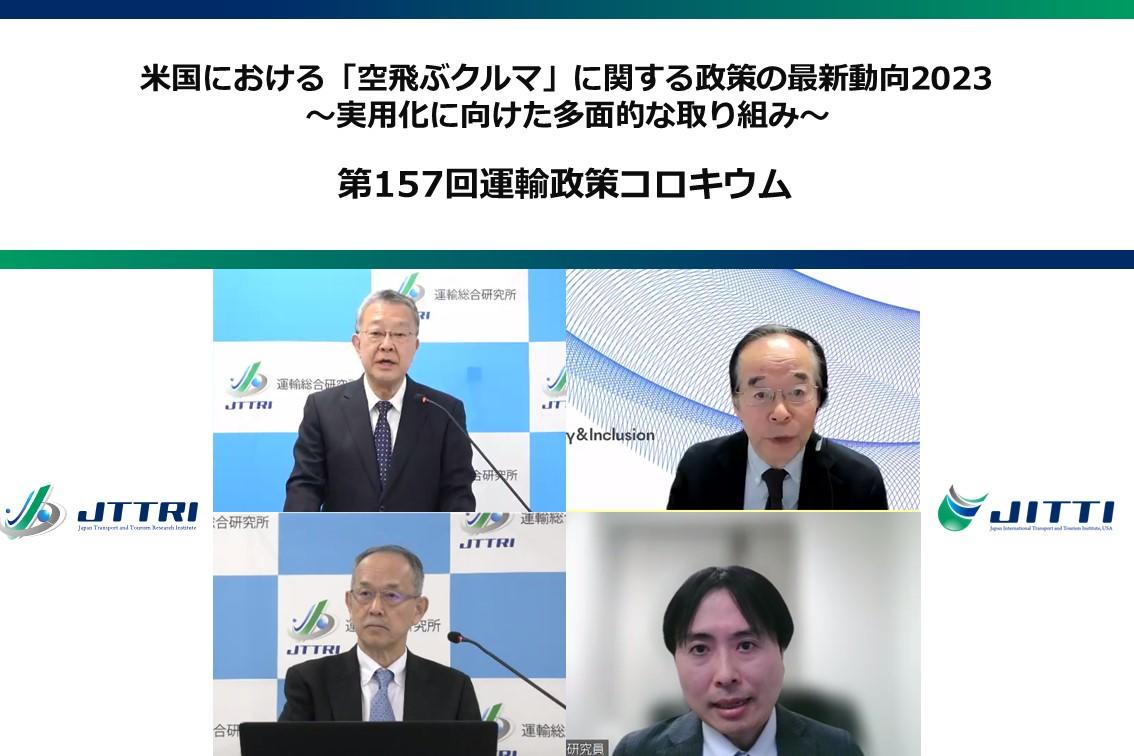Latest trends of Advanced Air Mobility policy in the United States 2023
- comprehensive approach for operations
- Colloquium
- Road transport
- New Technology and Innovation
The 157th Transport Policy Colloquium -Washington Report XVⅢ- (Online)
※Language:Japanese


| Date / Time | Tue, Dec 05,2023 |
|---|---|
| Event Number | The 157th |
| Theme | Lecture and Comment TSURI Shinichiro Japan International Transport and Tourism Institute, USA(JTTI-USA) SUZUKI Shinji Project Professor, Institute for Future Initiatives, the University of Tokyo Discussion Cordinator:YAI Tetsuo President for Research, JTTRI |
Event Summary
Amidst global expansion of the development and use of unmanned aerial vehicles (drones), Japan is working on introducing the commercial operation of the so-called “flying cars,” also known as Advanced Air Mobility (AAM), at the Expo 2025 Osaka, Kansai. All required systems and frameworks are due to be prepared by the end of FY2023. AAM’s commercial operation is also planned at 2024 Paris Olympics in Europe and also in 2025 in the United States, with many countries developing AAM aircraft and its operational systems for the launch. The Transport Policy Colloquium, held in January 2021, heard presentations about U.S. actions for the implementation of AAM, i.e. initiatives and development for addressing tasks and challenges involved.
Based on U.S. progress and up-to-date information, the latest Colloquium has examined the status of AAM aircraft development by venture business in various countries, as well as latest policy trends of the U.S. Federal Government on AAM (Advanced Air Mobility) including standards and concepts for type certification, operations and takeoff/landing sites, human resource development and social acceptance. Other presentations and discussions included AAM policy trends in Europe and Japan and considerations on the practical introduction of AAM in the future.
Main related SDGs




Program of the seminar is as the following
| Opening Remarks |
Tetsuya Okuda
Executive Director,Japan Transport and Tourism Research Institute (JTTRI) President, Japan International Transport and Tourism Institute, USA (JITTI USA) 
|
|---|---|
| Lecture and Comment | |
| Discussion |
Cordinator:YAI Tetsuo
President for Research, JTTRI 
|
Outline of the seminar
Today’s outcome:
Shinichiro Tsuri, Research Fellow of the Japan International Transport and Tourism Institute, USA in Washington D.C. conducted a presentation, “Latest trends of Advanced Air Mobility policy in the United States 2023 – Comprehensive approach for operations – .” Here are highlights of the presentation:
1. What is Advanced Air Mobility?
“Flying car,” as we call it in Japan, is referred to as “Advanced Air Mobility (AAM)” in the United States and “Innovative Air Mobility (IAM)” in Europe. The term “Urban Air Mobility (UAM)” is a subset of AAM or IAM referring to AAM that operates in urban and surrounding areas. Many countries envisage a new air transportation system based on advanced technologies such as eVTOL and automation.
2. Aircraft categories and development examples by country / manufacturer
eVTOL aircraft, mainly anticipated as AAM design, can be categorized into three types, namely Multi-rotor type, Lift-and-cruise type and Vectored thrust type.
① Multi-rotor type
The multi-rotor type is AAM that does not have fixed wings and uses a thrust mechanism consisting of three or more rotors for vertical take-off and landing. It is not suitable for high-speed operation and long-distance operation, but has a simple structure. Typical development examples include SkyDrive (Japan) and Volocopter (Germany).
② Lift-and-cruise type
The lift-and-cruise type is AAM that has fixed wings and uses different thrust mechanisms for vertical takeoff/landing and cruising. While being weighed down with the additional thrust mechanism, this type is more suited for high-speed and long-distance operations than the multi-rotor type due to the use of fixed wings. Typical development examples include the aircraft by Wisk Aero (US).
③ Vectored thrust type
The vectored thrust type is AAM that has fixed wings and uses the same thrust mechanism for vertical takeoff/landing and cruising. It has a slightly complicated structure and operation due to the need to change thrust orientation, but is more suitable for high-speed and long-distance operations than even the lift-and-cruise type. Typical development examples include models being developed by Joby Aviation (US) and Archer Aviation (US).
3. Latest policy trends and initiatives on AAM in the United States
An overview was given on the following U.S. policies and initiatives in the United States:
① Enactment of AAM-related laws
The Advanced Air Mobility Coordination and Leadership Act was enacted in October 2022, stipulating the establishment of an AAM interagency working group and a national strategy on AAM.
② Building a roadmap on UAM operation
The UAM ConOps (Concept of Operations) v2.0 was released in May 2023, setting out operational development in three stages, i.e. Initial Operations, Mid-term Operations and Mature state operations. It also described the development pathway for the UAM Corridors, which indicate airspaces specifically set aside for UAM operations.
③ Developing a vision for short-term achievement of AAM operations
The AAM Implementation Plan v1.0 was released in July 2023, providing a vision for short-term achievement of AAM operations by 2028.
④ Setting airworthiness criteria
With regard to eVTOL aircraft’s airworthiness criteria for type certification, the FAA has changed its policy from applying the 14 CFR Part 23 (airworthiness standards) for small aeroplanes to introducing new airworthiness standards for powered lift aircraft.
⑤ Regulatory amendment on pilot certification and operation standards
An NPRM (Notice of Proposed Rulemaking) suggesting changes to powered lift pilot certification and operation standards was issued in June 2023. It proposes that permanent changes are made, e.g. seeking type ratings without class ratings for powered lift category, and that a Special Federal Aviation Regulation be applied to determine which operating rules apply on a temporary basis to allow the FAA time to gather data and work out optimum changes.
⑥ Release of guidelines on vertiport
As transitional guidelines, the Engineering Brief No.105, Vertiport Design was released in September 2022, outlining vertiport design, geometry, safety considerations and various other factors.
⑦ Activities of the Advanced Aviation Advisory Committee (AAAC)
The AAAC is a committee that provides recommendations on UAS, AAM etc. to the DoT and FAA, and address tasks given by the FAA. It has presented recommendations on the use of gender-neutral language and the incorporation of studies about drones and AAM into the K-12 (compulsory education period in the United States) curriculum.
⑧ FAA AAM Summit
Jointly organized by the FAA and the Association for Uncrewed Vehicle Systems International, the first FAA AAM Summit was held in August 2023. It featured experts from the FAA, DoT, NASA, eVTOL manufacturers and overseas authorities as panelists to discuss a wide range of subjects including the ConOps, HR development and international harmonization.
4. Discussions and policy trends on AAM at international organizations as well as in Europe and Japan
The 41st session of the ICAO (International Civil Aviation Organization) Assembly resolved to establish the Advanced Air Mobility Study Group (AAM SG).
The European Union Aviation Safety Agency (EASA) is formulating various rules, releasing a Special Condition for small-category VTOL aircraft as the airworthiness standard, planning to draw up the new standard, Part-IAM, to address the operation of manned UAM, and issuing a guidance document on vertiport design. During Paris Olympics in 2024, Volocopter’s VoloCity is due to operate in Paris and its outskirts.
In Japan, the Public-Private Committee for Advanced Air Mobility has been set up under partnership between the private-, public- and academic sectors. It drew up the AAM Roadmap in December 2018, and set up various working groups under the Officials’ Meeting to discuss individual tasks. During Expo 2025 Osaka, Kansai, AAM operations are planned at the Expo site and linking two locations.
5. Practical implementation of AAM
From a short-term point of view, it is important to ensure AAM operation at the Expo 2025 Osaka, Kansai, pays attention to sufficient safety considerations and appeal its quiet and comfortable nature. Overseas examples and know-how should be studied and applied actively, such as lessons to be learned from eVTOL operation in the 2024 Paris Olympics and collaboration achieved under the Declaration of Cooperation in Advanced Air Mobility, signed between Japanese and U.S. authorities in 2022.
From a long-term point of view, international harmonization of AAM standards is required, highlighting the need to participate in ICAO’s effort to define international rules and harmonization activities among individual regulatory authorities. It is also important to develop human resources involved in AAM. One of the options is to promote women’s greater empowerment as a way of securing human resources in new growth industries.
Next, Shinji Suzuki, Project Professor of the Institute for Future Initiatives, the University of Tokyo conducted a presentation about challenges in social implementation of AAM. Highlights of the presentation were as follows:
・Urban passenger transport by helicopter is very convenient but also noisy and highly risky, as seen in the 1977 accident at the Pan Am Building, which killed five people.
・Last month, Joby Aviation and Volocopter conducted a demonstration flight of their eVTOL models in New York City, which was favorably received by local people including the NYC Mayor. In contrast, in Paris, where the launch of air taxi service is planned in time for the Paris Olympics next year, local authorities are raising opposition to passenger transport service using eVTOL aircraft.
・The introduction of new technology always has its opponents and proponents, creating the challenge of social acceptance. EASA’s 2021 study on the social acceptance of UAM showed a greater support for public service operations than private use in terms of use cases. The biggest concern is safety, but it should be alleviated if airworthiness standards are applied to UAM. Noise is the next main concern, and its acceptance depends on factors such as sound quality. The study also identified a limited trust in the cyber security of UAM. UAM’s social implementation would generate social benefits but also present social risks. A high-benefit mode of passenger transport tends to involve a high risk.
・As for AAM’s economic impact compared to that of existing means of transport, AAM offers no benefit in single-person private hire and cargo delivery. However, economic benefits are observed when transporting multiple people for 80km or greater, or as substitute for helicopter-based Flying Doctors services. Some studies point to possible fee reduction if self-driving becomes reality.
・NASA’s report on AAM missions for public good examined not only passenger transport but also public good missions such as infrastructure inspections and disaster response as AAM’s use cases.
・AAM involves system risks in terms of aircraft certification (e.g. assessment of electric-drive systems), pilot skills (skills required for powered-lift aircraft, use of simulators etc.) and AAM operation (operating management, vertiport requirements etc.).
・Business risks include AAM development in the absence of a certification system or market, and business deployment in the absence of established social acceptance. It is necessary to accurately analyze technological, systematic and business risks, and explore mitigation measures.
The discussion session that followed started with Research Fellow Tsuri providing answers to questions presented by Project Professor Suzuki.
[Project Professor Suzuki]
Would noise become an issue at and around AAM takeoff / landing sites with respect to AAM operation in urban areas? What is United States’ awareness and regulatory status on noise generated by AAM?
[Research Fellow Tsuri]
AAM manufacturers are conscious about the issue of noise and quietness of operation from the perspective of social acceptance. The U.S. regulations have yet to present standards specific to the noise of AAM aircraft in a similar way to airworthiness standards. The FAA’s approach is to examine, on a model-by-model basis, whether noise regulations for helicopters and tiltrotors in the existing 14 CFR Part 36 could be applied. If this is not appropriate, new application criteria could be drawn up for the applicable model. Currently the FAA is planning to undertake an overarching Noise Policy Review. There is possibility that 14 CFR Part 150 may be updated to accommodate AAM operations.
[Project Professor Suzuki]
There are media reports that U.S. military is showing interest in AAM. In terms of security, what applications and how much demand are they envisaging?
[Research Fellow Tsuri]
The U.S. Air Force is partnering with numerous AAM manufacturers for a project called Agility Prime, which taps into government resources to support private-sector development of eVTOL aircraft. Specific applications of eVTOL aircraft, taking advantage of its low-noise performance and un-manned operation capability, appear to include sending and evacuating special forces, and conducting a search & rescue mission on enemy territories inaccessible with conventional aircraft. The U.S. Marine Corps may be considering using eVTOL aircraft to transport supplies and reinforcements to small-scale units that are spread across enemy territories. As for demand, the U.S. Air Force has signed deals to acquire up to 9 eVTOL units from Joby (first one delivered in September 2023) and up to 6 Midnight units from Archer. These figures may increase further once the effectiveness of eVTOL aircraft is confirmed.
Then, the Colloquium’s coordinator and JTTRI’s President Tetsuo Yai held discussions with Project Professor Suzuki and Research Fellow Tsuri, while also answering questions from participants. Here are the highlights:
[President Yai]
There was a talk about the issue of noise. How would AAM’s noise compare to that of conventional helicopters?
[Research Fellow Tsuri]
AAM is electrical and therefore much quieter than conventional aircraft in terms of volume. However, as Professor Suzuki explained, the frequency or repetition of sound affects the level of social acceptance. Unlike conventional modes of transport, AAM is anticipated to fly around urban areas frequently. This makes the issue of noise quite important.
[Project Professor Suzuki]
AAM noise has quite a different property to the noise of conventional aircraft, and some may suffer greater annoyance from it. There will be heavy concentration of AAM operations near vertiports for takeoffs and lands. I’ve heard of a plan to allow AAM to approach to vertiports omnidirectionally, rather than in single direction.
[President Yai]
As Professor Suzuki pointed out, numerous system risks must be overcome to achieve AAM operation. One participant has pointed to media reports several years ago predicting that commercial AAM operations would start by around 2023 in some industrialized nations in Europe and North America. What are background factors that prevented this prediction from actualizing?
[Research Fellow Tsuri]
There have been various factors including the protracted pandemic of COVID-19. At the same time, I have felt, through interactions with U.S. authorities, that the FAA proceeded cautiously through trials and errors due to self-admitted lack of experience in AAM despite extensive experiences with conventional aircraft. This has been reflected to FAA’s change of policy on airworthiness standards and SFAR’s temporary amendment approach in updating powered lift regulations.
[Project Professor Suzuki]
I am the chair of the Public-Private AAM Committee’s aircraft safety working group. We have yet to see an actual example of full-scale electric aircraft and still need to work on proving AAM’s safety in public-private partnership. Currently all countries are on an equal footing, making it easy for Japan to set a goal.
[President Yai]
A participant asked if the UAM Corridors, mentioned in a segment about AAM operation, are something that eyes can see. My understanding is that they are invisible areas defined in airspace. In the case of AAM operation during the Expo, what would be the flight altitude and how do takeoffs and landings work, considering that the flight path between the Expo site and the vertiport near Osaka Castle is urban areas?
[Research Fellow Tsuri]
As of 2025, no UAM Corridor is defined. UAM operation will be based on existing aviation rules. With regard to the flight path linking a vertiport in the city and the Expo site, which is just the point, stakeholders are in discussions as to whether UAM should avoid land areas and fly over the river, or whether it should fly over land areas while securing a certain level of altitude and places for emergency landing.
[Project Professor Suzuki]
For AAM, there is a suggested approach of issuing aircraft certification and flight permit with restrictions on operational method and airspaces used. This would be different from the approach for conventional aircraft, which can fly anywhere except for off-limit airspaces once aircraft certification is received.
[President Yai]
(Question from a participant) Battery performance is seriously affected by its age and operating temperatures. What discussions are being made in the United States about contingency fuel?
[Research Fellow Tsuri]
Contingency fuel is one of the factors being examined in the United States. The NPRM for powered lift operations suggest having contingency fuel enough to secure a 30-minute flight, which is the same as the requirement for conventional airplanes. This is a conservative approach compared to Europe, which maintains that contingency fuel can be minimized by measures such as securing multiple emergency landing sites. Vertiport guidelines require weather-observation facilities due to the importance of local weather conditions. Batteries do not withstand extreme temperatures well. Considering that batteries are used for on-board air conditioning in commercial operation, extremely high or low temperatures would affect the contingency fuel requirement if AAM service routes are defined to the maximum performance of aircraft involved.
[Project Professor Suzuki]
Similarly to electric vehicles, AAM’s cruising distance can be affected by temperature conditions and usage. It is necessary to incorporate a system that accurately estimates battery usage into aircraft. One of the major issues of lithium-ion batteries is the possibility of fire and difficulty in extinguishing it once it starts. This is why safety assurance measures must be part of aircraft design. Unlike cars, AAM is subject to strict weight restrictions. A hybrid system that makes combined use of a piston engine is not easy to develop, but Honda is working on developing hybrid AAM aircraft equipped with a compact jet engine.
[President Yai]
What is Professor Suzuki’s view on unmanned AAM operation?
[Project Professor Suzuki]
Some studies predict that remotely-operated AAM services should become reality by 2035 – 2040. Some models are being developed on the premise of remote-controlled self-driving from the start, e.g. EHang of China and Wisk of the United States. It is technologically viable but it is an entirely separate matter if it becomes accepted by our society at large.
[President Yai]
(Question from a participant) In the future, will there be AAM development of aircraft capable of flying in IFR weather conditions, including rough weather and at night? Would the recent accident involving Osprey become an impediment to social acceptance of VTOL aircraft?
[Research Fellow Tsuri]
AAM will fly under VFR rules for now but could cater to IFR conditions in the future. For example, Generation 6 by Wisk is developed to comply with instrumental requirements for IFR. The Osprey accident could raise social concerns about vertical takeoff and landing aircraft. In order to boost social acceptance, it is important to increase awareness, as highlighted by Professor Suzuki, that AAM can be used for public good services in addition to passenger transport.
[Project Professor Suzuki]
In Japan, some say AAM should be used for people in mountainous areas, remote islands and other remote communities that cannot be accessed by public transport. Such an application can be leveraged to boost social acceptance for AAM.




